Feasibility Study of Closed-Loop Recycling for Plastic Generated from Waste Electrical and Electronic Equipment (WEEE) in South Korea
Abstract
:1. Introduction
2. Materials and Methods
2.1. Estimation of the Generation of Recycled Plastics
2.2. Physical Properties by Material
2.3. Physical and Chemical Properties of Recycled Plastics and Virgin Plastics
2.4. Greenhouse Gas (GHG) Emission Avoidance through Recycled Plastics
3. Results and Discussion
3.1. Generation of WEEE and Plastic Waste as the Subject of Investigation
3.1.1. Generation of Recycled Plastics from Large-Scale WEEE
3.1.2. Generation of Recycled Plastics from Small- and Medium-Scale WEEE
3.2. Physical and Chemical Properties of Recycled Plastics and Virgin Plastics
3.3. GHG Emission Avoidance through Recycled Plastics
4. Conclusions
Supplementary Materials
Author Contributions
Funding
Data Availability Statement
Conflicts of Interest
Abbreviations
| ABS | Acrylonitrile Butadiene Styrene |
| ABSFR | Fiber-Reinforced ABS |
| ASTM | American Society for Testing Method |
| Br | Bromine |
| EPR | Extended Producer Responsibility |
| ErP | Energy-related Products |
| ESPR | Ecodesign for Sustainable Products Regulation |
| EuP | Energy-using Products |
| GF | Glass Fiber |
| GFPP | Glass Fiber Polypropylene |
| GHG | Greenhouse Gas |
| GPPS | General Purpose Polystyrene |
| GR | Good Recycled Product |
| GWP | Global Warming Potential |
| HIPP | High-Impact Polypropylene |
| IPCC | Intergovernmental Panel on Climate Change |
| ISO | International Organization for Standardization |
| LCA | Life Cycle Assessment |
| LCI | Life Cycle Inventory |
| PA | Polyacrylate |
| PC | Polycarbonate |
| PCABS | PC and ABS |
| PCR | Post-Consumer Recycled |
| PET | Polyethylene terephthalate |
| PP | Polypropylene |
| PS | Polystyrene |
| RoHS | Restriction of the use of Hazardous Substances in EEE |
| UL | Underwriter’s Laboratories |
| WEEE | Waste Electrical and Electronic Equipment |
References
- Our World in Data. Available online: https://ourworldindata.org/plastic-pollution (accessed on 1 July 2023).
- European Commission. Directive (EU) 2019/904 of the European Parliament and of the Council of 5 June 2019 on the Reduction of the Impact of Certain Plastic Products on the Environment; The Official Journal of the European Union: Brussels, Belgium, 2019; pp. 1–19. [Google Scholar]
- EU Commission. Directive (EU) 2015/720 of the European Parliament and of the Council of 29 April 2015 Amending Directive 94/62/EC as Regards Reducing the Consumption of Lightweight Plastic Carrier Bags; The Official Journal of the European Union: Brussels, Belgium, 2015; pp. 11–15. [Google Scholar]
- Lee, K.; Jang, J.; Lee, C. E-Waste EV Batteries as Key Players in the E-Waste Market; Samsung Securities: Seoul, Republic of Korea, 2022. [Google Scholar]
- Samil PwC Research Institute. Transition to a Circular Economy and Response Strategies, with a Focus on Plastics and Secondary Batteries; Samil PwC Research Institute: Daegu, Republic of Korea, 2022. [Google Scholar]
- Lee, S. Current Status and Implications of International Plastic Regulations; World Economy Focus: Sejong, Republic of Korea, 2022. [Google Scholar]
- Cesiulis, H.; Tsyntsaru, N. Eco-Friendly Electrowinning for Metals Recovery from Waste Electrical and Electronic Equipment (WEEE). Coatings 2023, 13, 574. [Google Scholar] [CrossRef]
- Buekens, A.; Yang, J. Recycling of WEEE plastics: A review. J. Mater. Cycles Waste Manag. 2014, 16, 415–434. [Google Scholar] [CrossRef]
- Choi, Y.; Kim, S. Regulatory Trends and Industry Responses Regarding Waste Electrical and Electronic Equipment (WEEE) in Major Countries; COMPASS: Seoul, Republic of Korea, 2013. [Google Scholar]
- Ghisellini, P.; Ulgiati, S. Circular economy transition in Italy. Achievements, perspectives and constraints. J. Clean. Prod. 2020, 243, 118360. [Google Scholar] [CrossRef]
- European Commission. Directive 2012/19/EU of the European Parliament and of the Council of 4 July 2012 on Waste Electrical and Electronic Equipment (WEEE); The Official Journal of the European Union: Brussels, Belgium, 2012; pp. 1–40. [Google Scholar]
- EU Commission. Communication from the Commission to the European Parliament, the Council, the European Economic and Social Committee and the Committee of the Regions a New Circular Economy Action Plan for a Cleaner and More Competitive Europe; The Official Journal of the European Union: Brussels, Belgium, 2020; pp. 1–20. [Google Scholar]
- Kim, S.; Hong, K. Regulatory Trends of Disposable Plastic Products in China; COMPASS: Seoul, Republic of Korea, 2021. [Google Scholar]
- EU Commission. Directive 2009/125/EC of the European Parliament and of the COUNCIL of 21 October 2009 Establishing a Framework for the Setting of Ecodesign Requirements for Energy-Related Products; The Official Journal of the European Union: Brussels, Belgium, 2009; pp. 10–35. [Google Scholar]
- Shin, K. EU Announces New Ecodesign Regulations; Korea International Trade Association: Seoul, Republic of Korea, 2022. [Google Scholar]
- Kim, S.; Lee, J. Key Revisions of Korea RoHS (Korea Restriction of Hazardous Substances) Law for Electrical and Electronic Products (Preventive Provisions); COMPASS: Seoul, Republic of Korea, 2019. [Google Scholar]
- Korea Ministry of Environment (Korea MOE). Comprehensive Plan for Recycling Waste Management; Korea Ministry of Environment (Korea MOE): Sejong, Republic of Korea, 2018. [Google Scholar]
- Korea Ministry of Environment (Korea MOE). Strategies for Plastic-Free Waste in Daily Life; Korea Ministry of Environment (Korea MOE): Sejong, Republic of Korea, 2020. [Google Scholar]
- Korea Ministry of Trade, Industry and Energy (Korea MOTIE); Korea Ministry of Environment (Korea MOE). Establishment of Korea-Style Circular Economy Implementation Plan for Carbon Neutrality; Korea Ministry of Environment (Korea MOE): Sejong, Republic of Korea, 2020. [Google Scholar]
- Korea Ministry of Environment (Korea MOE). Comprehensive Strategies for Plastic-Free Life Cycle; Korea Ministry of Environment (Korea MOE): Sejong, Republic of Korea, 2022. [Google Scholar]
- Jang, Y. (Chungnam National University, Daedeok, Daejeon, Republic of Korea). Personal communication, 2022.
- Heo, T. Recycling of Waste Plastics and Life Cycle Assessment (LCA). Recycl. J. 2003, 1, 74–79. [Google Scholar]
- Ghisellini, P.; Quinto, I.; Passaro, R.; Ulgiati, S. Circular Economy Management of Waste Electrical and Electronic Equipment (WEEE) in Italian Urban Systems: Comparison and Perspectives. Sustainability 2023, 15, 9054. [Google Scholar] [CrossRef]
- Chen, S.; Zhang, J.; Kim, J. Life cycle analysis of greenhouse gas emissions for fluorescent lamps in mainland China. Sci. Total Environ. 2017, 575, 467–473. [Google Scholar] [CrossRef]
- Choi, W.Z. A study on physical characteristics and plastics recycling of used small household appliances. Resour. Recycl. 2016, 25, 31–39. [Google Scholar]
- EU Commission. Directive 2011/65/EU of the EUROPEAN Parliament and of the COUNCIL of 8 June 2011 on the Restriction of the Use of Certain Hazardous Substances in Electrical and Electronic Equipment; The Official Journal of the European Union: Brussels, Belgium, 2011; pp. 88–110. [Google Scholar]
- Kim, J.; Lee, S.; Kim, G.H.; Cho, S.S.; Hong, H.S. Effects of Polymer Additives on Mechanical Properties of Recycled Plastic Composites. J. Korean Soc. Miner. Energy Resour. Eng. 2010, 47, 653–659. [Google Scholar]
- Choi, H.-J.; Choi, Y.; Rhee, S.-W. The strategy for management of plastic waste in Korea through the recycling policy in developed countries. J. Korean Soc. Waste Manag. 2018, 35, 709–720. [Google Scholar] [CrossRef]
- Nielsen, T.D.; Hasselbalch, J.; Holmberg, K.; Stripple, J. Politics and the plastic crisis: A review throughout the plastic life cycle. Wiley Interdiscip. Rev. Energy Environ. 2020, 9, e360. [Google Scholar] [CrossRef]
- KS I ISO 14040:2006; Environmental Management—Life Cycle Assessment—Principles and Framework. Korean Standards & Certification: Chungbuk, Republic of Korea.
- KS I ISO 14044:2006; Environmental Management—Life Cycle Assessment—Requirements and Guidelines. Korean Standards & Certification: Chungbuk, Republic of Korea.
- Ghisellini, P.; Cialani, C.; Ulgiati, S. A review on circular economy: The expected transition to a balanced interplay of environmental and economic systems. J. Clean. Prod. 2016, 114, 11–32. [Google Scholar] [CrossRef]
- Mannheim, V.; Simenfalvi, Z. Total life cycle of polypropylene products: Reducing environmental impacts in the manufacturing phase. Polymers 2020, 12, 1901. [Google Scholar] [CrossRef]
- Alsabri, A.; Tahir, F.; Al-Ghamdi, S.G. Lifecycle assessment of polypropylene production in the gulf cooperation council (GCC) region. Polymers 2021, 13, 3793. [Google Scholar] [CrossRef] [PubMed]
- Mannheim, V. Life cycle assessment model of plastic products: Comparing environmental impacts for different scenarios in the production stage. Polymers 2021, 13, 777. [Google Scholar] [CrossRef] [PubMed]
- Ghisellini, P.; Passaro, R.; Ulgiati, S. Environmental and Social Life Cycle Assessment of Waste Electrical and Electronic Equipment Management in Italy According to EU Directives. Environments 2023, 10, 106. [Google Scholar] [CrossRef]
- Ismail, H.; Hanafiah, M.M. An overview of LCA application in WEEE management: Current practices, progress and challenges. J. Clean. Prod. 2019, 232, 79–93. [Google Scholar] [CrossRef]
- Wäger, P.A.; Hischier, R. Life cycle assessment of post-consumer plastics production from waste electrical and electronic equipment (WEEE) treatment residues in a Central European plastics recycling plant. Sci. Total Environ. 2015, 529, 158–167. [Google Scholar] [CrossRef]
- Hischier, R.; Wäger, P.; Gauglhofer, J. Does WEEE recycling make sense from an environmental perspective?: The environmental impacts of the Swiss take-back and recycling systems for waste electrical and electronic equipment (WEEE). Environ. Impact Assess. Rev. 2005, 25, 525–539. [Google Scholar] [CrossRef]
- Song, Q.; Wang, Z.; Li, J. Sustainability evaluation of e-waste treatment based on emergy analysis and the LCA method: A case study of a trial project in Macau. Ecol. Indic. 2013, 30, 138–147. [Google Scholar] [CrossRef]
- Ghiga, S.C.; Simion, I.M.; Filote, C.; Roșca, M.; Hlihor, R.M.; Gavrilescu, M. Comparative Analysis of Three WEEE Management Scenarios Based on LCA Methodology: Case Study in the Municipality of Iasi, Romania. Processes 2023, 11, 1305. [Google Scholar] [CrossRef]
- Spreafico, C.; Landi, D.; Russo, D. A new method of patent analysis to support prospective life cycle assessment of eco-design solutions. Sustain. Prod. Consum. 2023, 38, 241–251. [Google Scholar] [CrossRef]


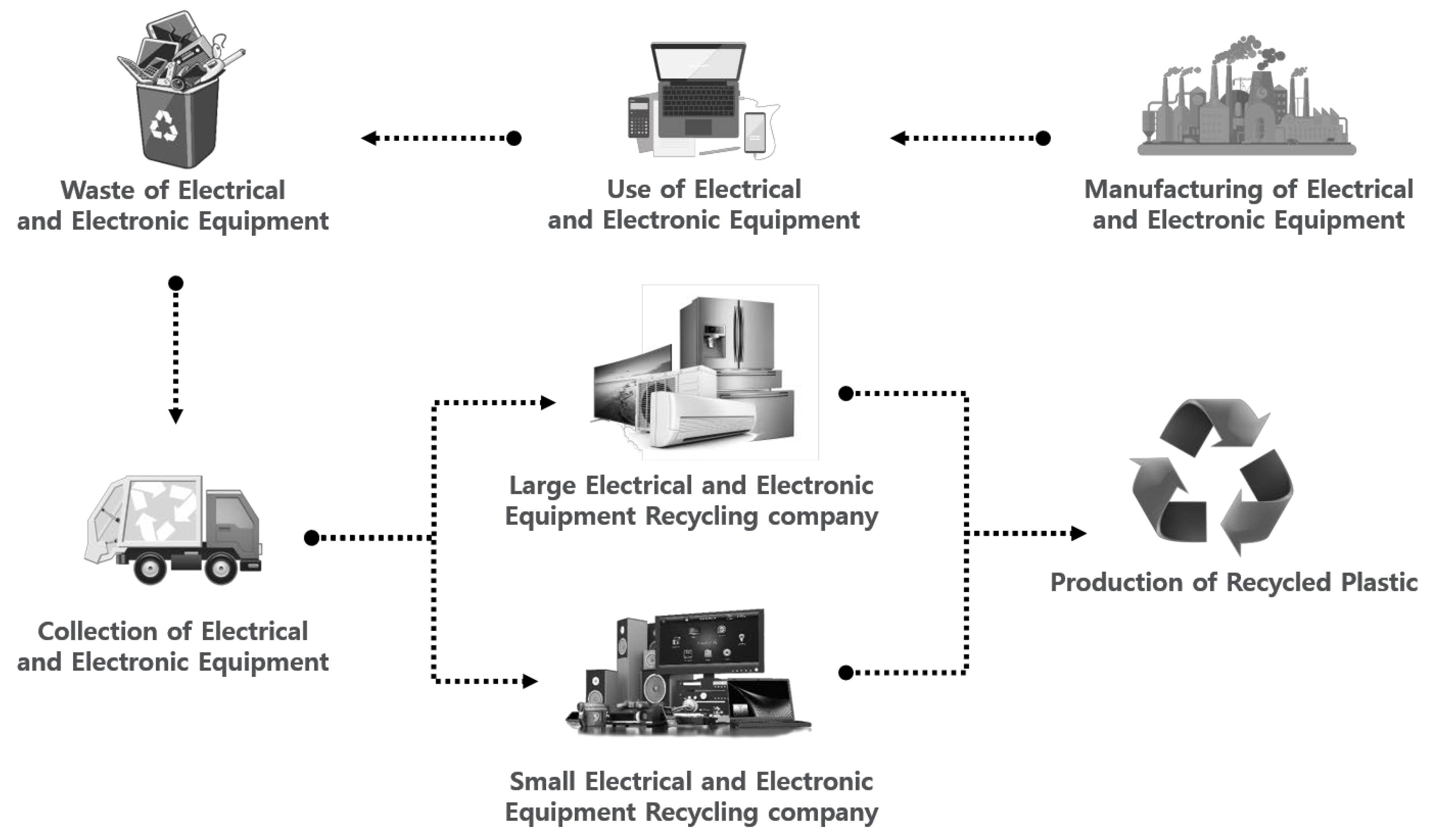
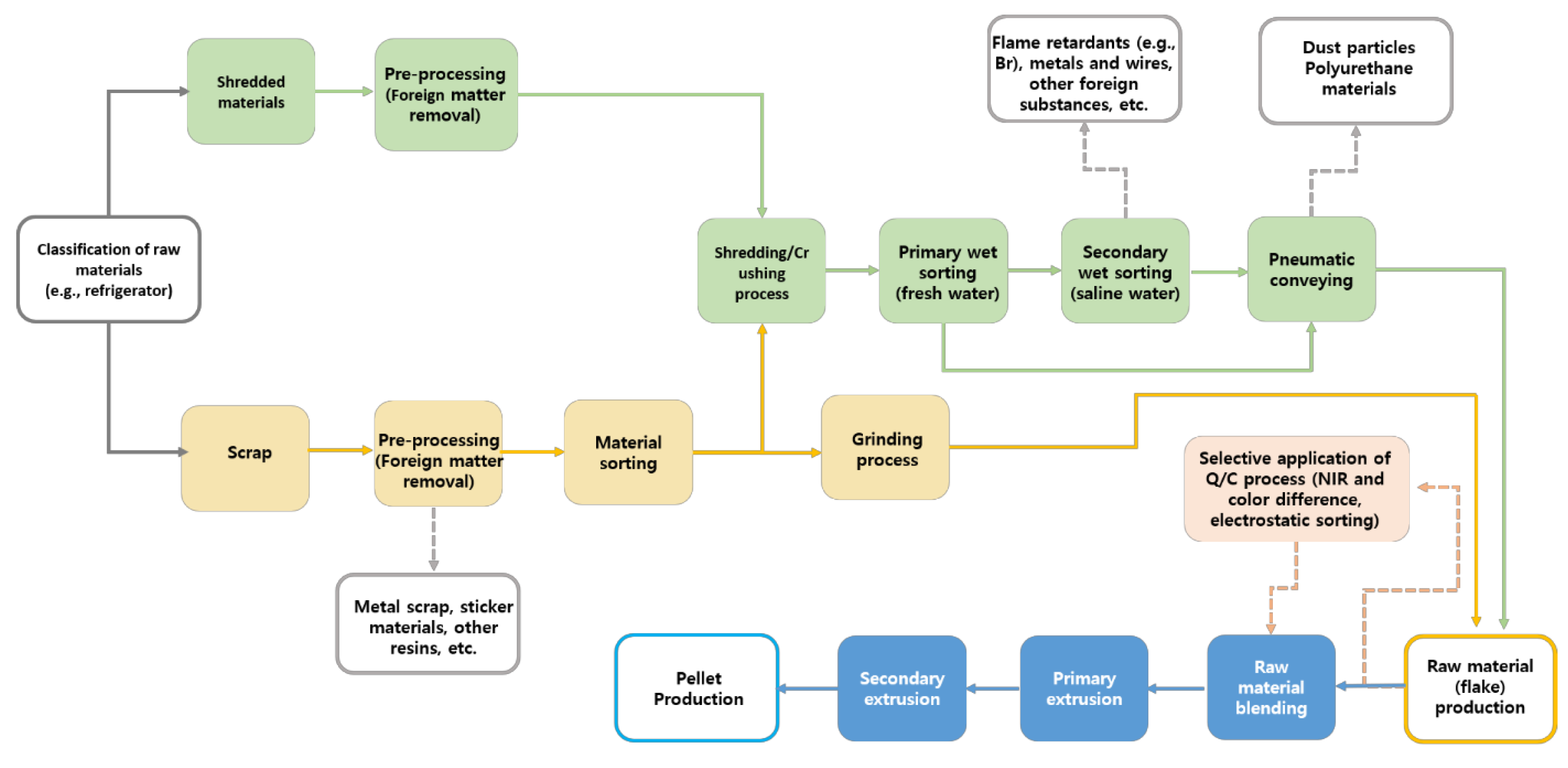
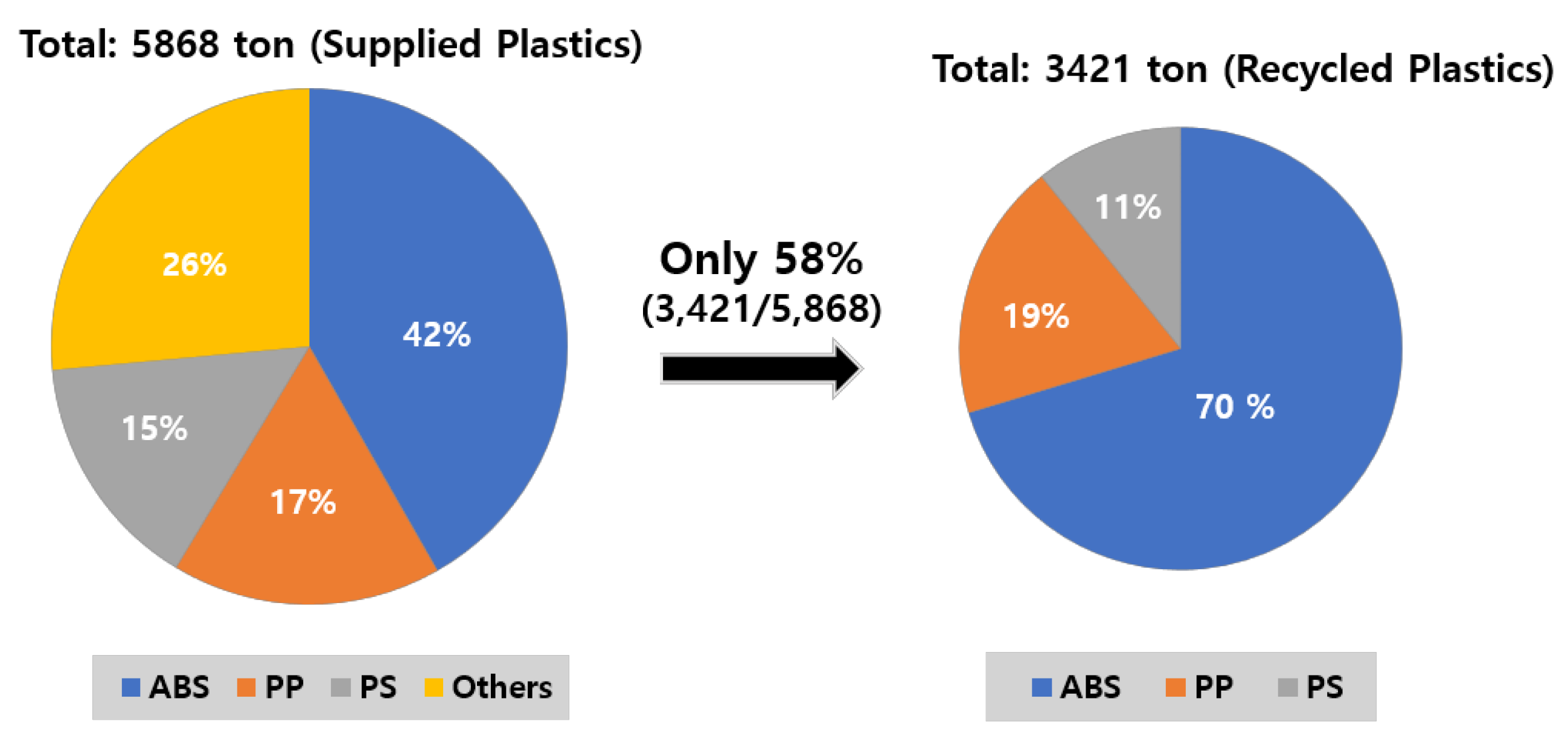
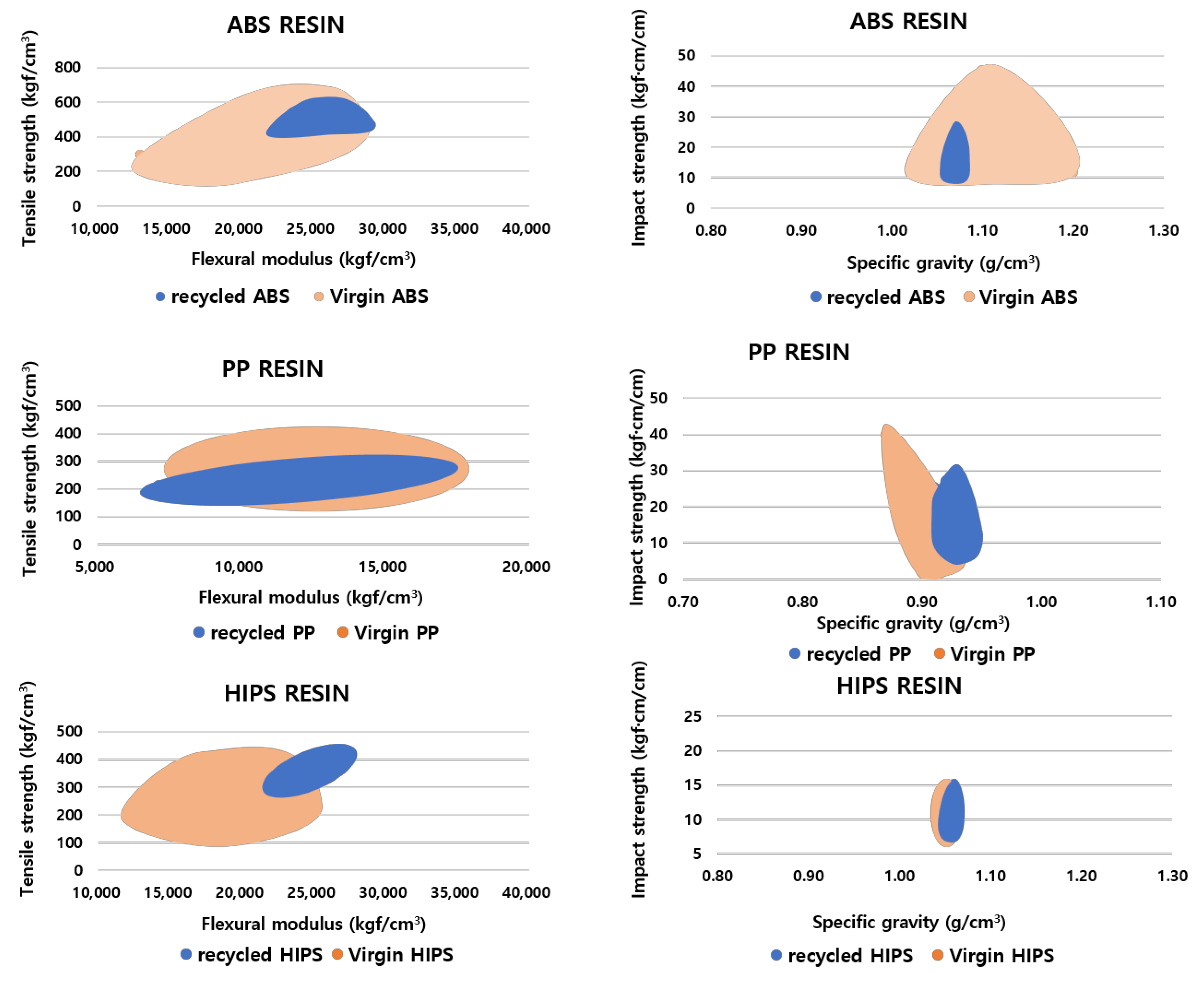



| Classification | Contents | |
|---|---|---|
| EU | WEEE Directive | For electronic products with a rated voltage of up to 1000 V AC and 1500 V DC, when they reach the end of their lifespan, their collection, treatment, and recycling contribute to sustainable production and consumption improvements, increased resource efficiency, and the promotion of a circular economy. |
| New circular economy action plan | The design implementation follows eco-design regulations, prioritizing factors such as device efficiency, durability, repairability, and upgradeability and considerations for maintenance, reuse, and recycling. | |
| USA | New York State | Manufacturers must establish systems for collecting, managing, recycling, or reusing waste products for small electronic products, such as computers, televisions, and computer peripherals. They are also required to operate and maintain electronic waste disposal programs. |
| Texas State | An individual producer responsibility system is applied, requiring manufacturers to collect and recycle their products. They must prepare and submit an annual report specifying the weights associated with the collection and recycling processes. | |
| Japan | The Small Electronic Waste Recycling Promotion Law | Under an individual producer responsibility system, manufacturers must collect and recycle their products. They must also prepare and submit annual reports that include the weight of products collected and recycled during the designated process. |
| China | Regulation on the Collection and Disposal Management of Waste Electrical and Electronic Products | Design techniques are applied to support resource conservation and adopt environmentally sound waste-disposal methods. Product recycling information and information on toxicity and hazardous substances are provided to aid this effort. |
| Category | Product | Recycling Amount (ton) |
|---|---|---|
| Temperature Exchanger | Refrigerator | 191,349 |
| Electric water purifier | 17,786 | |
| Vending machine (including temperature exchange function) | 1032 | |
| Air conditioner | 8654 | |
| Dehumidifier | 263 | |
| Display Device | Television | 29,178 |
| Computer (e.g., monitors and laptops) | 2100 | |
| Navigation system | 10 | |
| Telecommunication equipment | Computer (main unit, components, and peripherals) | 12,290 |
| Copiers | 4238 | |
| Printers | 5280 | |
| Fax machines | 146 | |
| Scanners | 38 | |
| Beam Projectors | 37 | |
| Wireless routers | 107 | |
| Mobile phone handsets | 84 | |
| General electric/electronic products | Washing machines | 70,426 |
| Electric ovens | 382 | |
| Microwaves | 1302 | |
| Food waste disposers | 72 | |
| Dish dryers& Dishwashers | 1151 | |
| Electric bidets | 1755 | |
| Air purifiers | 3521 | |
| Electric heaters | 33 | |
| Audio systems | 324 | |
| Electric rice cookers | 1175 | |
| Water softeners | 289 | |
| Humidifiers | 32 | |
| Electric irons | 82 | |
| Fans | 161 | |
| Blenders | 73 | |
| Vacuum cleaners | 423 | |
| Video players | 21 | |
| Toasters | 20 | |
| Electric kettles | 30 | |
| Electric water heaters | 36 | |
| Electric frying pans | 56 | |
| Hair dryers | 16 | |
| Treadmills | 504 | |
| Surveillance cameras | 4 | |
| Food dehydrators | 10 | |
| Electric massagers | 3277 | |
| Foot baths | 18 | |
| Sewing machines | 12 | |
| Video game consoles | 10 | |
| Bread makers | 26 | |
| Deep fryers | 47 | |
| Coffee makers | 124 | |
| Herbal medicine baths | 38 | |
| Spin dryers | 12 | |
| Vending machines (excluding temperature exchange functions) | 33 | |
| General electric/electronic products mixture | 69,151 | |
| Total | 427,238 |
| ABS | PP | PS | Others | Total | |
|---|---|---|---|---|---|
| Weight (ton) * | 2464 | 997 | 880 | 1526 | 5868 |
| Weight (ton) ** | 2406 | 645 | 370 | - | 3421 |
| Proportion (%) *** | 97.7 | 64.7 | 42 | - | 58.3 |
| ABS | PP | PS (HIPS + GPPS) | Others | Total | |
|---|---|---|---|---|---|
| Weight (ton) * | 32,801 | 13,277 | 11,715 | 20,306 | 78,099 |
| Weight (ton) ** | 32,020 | 8591 | 4920 | - | 45,531 |
| ABS | PP | PS | Others | Total | |
|---|---|---|---|---|---|
| Weight (ton) * | 1346 | 545 | 481 | 833 | 3205 |
| Weight (ton) ** | 1315 | 353 | 202 | - | 1870 |
| Proportion (%) *** | 98 | 65 | 42 | - | 58.3 |
| Ratio (%) | Dehumidifier (27) | Air Purifier (70) | Water Purifier (16) |
|---|---|---|---|
| ABS | 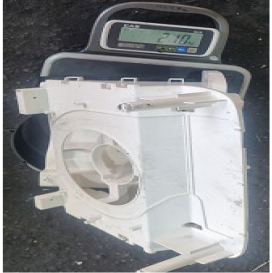 | 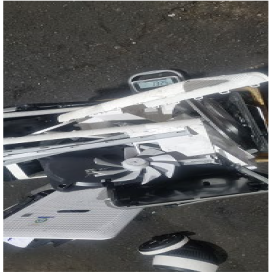 | 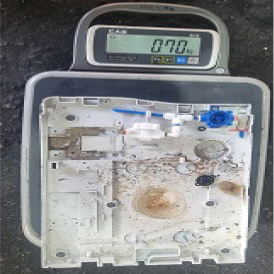 |
| Ratio (%) | Electric rice cooker (26) | Vacuum cleaner (34) | Electric bidet (35) |
| PP |  |  | 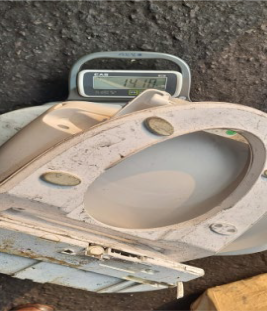 |
| Ratio (%) | Audio system (43) | Printer (43) | Keyboard (69) |
| PS | 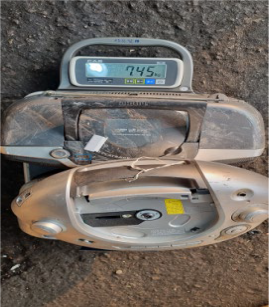 |  | 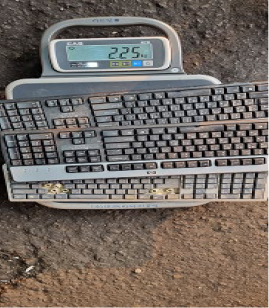 |
| ABS | PP | PS (HIPS + GPPS) | Others | Total | |
|---|---|---|---|---|---|
| Weight (ton) * | 21,846 | 8846 | 7807 | 13,520 | 52,019 |
| Weight (ton) ** | 21,343 | 5729 | 3279 | - | 30,351 |
| ABS | PP | PS (HIPS + GPPS) | Others | Total | |
|---|---|---|---|---|---|
| Weight (ton) * | 54,647 | 22,123 | 19,522 | 33,826 | 130,118 |
| Weight (ton) ** | 53,363 | 14,320 | 8199 | - | 75,882 |
| Test Type | Tensile Strength | Elongation | Impact Strength | Specific Gravity | Melt Flow Index | Flexural Strength | Flexural Modulus | Hazardous Substances |
|---|---|---|---|---|---|---|---|---|
| 50 mm/min Properties | 3.2 mm | 1/8 Notched, 3.2 mm | - | 220 °C/10 kg | 10 min/min, 3.2 mm | Br | ||
| Method | ASTM D638 | ASTM D256 | ASTM D792 | ASTM D1238 | ASTM D790 | X-ray | ||
| Unit | Kgf/cm2 | % | kgf·cm/cm | g/cm3 | g/10 min | kgf/cm2 | mg/kg | |
| LC ABS #1 | 498.33 | 15.24 | 12.65 | 1.07 | 17.20 | 825.88 | 26,993.93 | 169.0 |
| LC ABS #2 | 501.08 | 15.94 | 12.89 | 1.07 | 20.10 | 822.41 | 25,768.24 | 157.6 |
| LC ABS #3 | 504.65 | 14.76 | 12.01 | 1.07 | 18.80 | 837.93 | 26,696.83 | 176.1 |
| SC ABS #1 | 493.90 | 16.38 | 11.69 | 1.06 | 19.40 | 807.95 | 26,151.13 | 153.6 |
| SC ABS #2 | 495.77 | 14.95 | 11.95 | 1.06 | 22.52 | 805.14 | 25,862.27 | 141.8 |
| SC ABS #3 | 496.66 | 21.82 | 11.66 | 1.06 | 21.38 | 788.06 | 25,165.980 | 145.6 |
| LC PS #1 | 375.97 | 38.40 | 10.48 | 1.06 | 14.26 | 585.79 | 25,839.26 | 11.9 |
| LC PS #2 | 385.53 | 36.45 | 10.44 | 1.06 | 14.88 | 599.01 | 24,447.04 | 5.1 |
| LC PS #3 | 377.17 | 34.81 | 10.29 | 1.06 | 14.84 | 619.89 | 26,136.95 | 3.4 |
| SC PS #1 | 333.00 | 27.71 | 8.04 | 1.05 | 16.38 | 548.61 | 23,580.14 | 581.6 |
| SC PS #2 | 334.41 | 25.04 | 8.34 | 1.05 | 16.90 | 542.24 | 23,826.92 | 534.1 |
| SC PS #3 | 338.98 | 30.99 | 8.73 | 1.05 | 15.92 | 547.31 | 24,233.79 | 576.2 |
| LC PP #1 | 256.62 | 38.15 | 8.05 | 0.92 | 17.58 | 383.53 | 13,354.34 | 54.0 |
| LC PP #2 | 253.02 | 47.19 | 8.95 | 0.92 | 17.00 | 339.62 | 11,559.86 | 66.4 |
| LC PP #3 | 253.65 | 31.76 | 8.08 | 0.92 | 18.84 | 373.25 | 12,810.61 | 76.3 |
| SC PP #1 | 287.89 | 122.54 | 5.18 | 0.95 | 7.20 | 340.23 | 11,870.05 | 115.5 |
| SC PP #2 | 245.53 | 8.52 | 4.62 | 0.95 | 11.60 | 345.78 | 12,877.97 | 151.4 |
| SC PP #3 | 252.01 | 34.72 | 7.04 | 0.94 | 8.08 | 332.11 | 11,842.88 | 99.1 |
| Database | Emission Factor (kg CO2-eq./kg) | Location |
|---|---|---|
| crylonitrile-butadiene-styrene copolymer production | 4.5624 | Europe |
| polypropylene production, granulate | 1.9003 | |
| polystyrene production, general purpose | 3.6747 | |
| Material production, Recycled plastic from WEEE rABS, granulates; From WEEE collection to plastic granulates; In the context of French WEEE take-back schemes and European regeneration | 0.5413 | Europe |
| Material production, Recycled plastic from WEEE rPP, granulates; From WEEE collection to plastic granulates; In the context of French WEEE take-back schemes and European regeneration | 0.421 | |
| Material production, Recycled plastic from WEEE rPS, granulates; From WEEE collection to plastic granulates; In the context of French WEEE take-back schemes and European regeneration | 0.591 |
Disclaimer/Publisher’s Note: The statements, opinions and data contained in all publications are solely those of the individual author(s) and contributor(s) and not of MDPI and/or the editor(s). MDPI and/or the editor(s) disclaim responsibility for any injury to people or property resulting from any ideas, methods, instructions or products referred to in the content. |
© 2023 by the authors. Licensee MDPI, Basel, Switzerland. This article is an open access article distributed under the terms and conditions of the Creative Commons Attribution (CC BY) license (https://creativecommons.org/licenses/by/4.0/).
Share and Cite
Choi, W.H.; Pae, K.P.; Kim, N.S.; Kang, H.Y.; Hwang, Y.W. Feasibility Study of Closed-Loop Recycling for Plastic Generated from Waste Electrical and Electronic Equipment (WEEE) in South Korea. Energies 2023, 16, 6358. https://doi.org/10.3390/en16176358
Choi WH, Pae KP, Kim NS, Kang HY, Hwang YW. Feasibility Study of Closed-Loop Recycling for Plastic Generated from Waste Electrical and Electronic Equipment (WEEE) in South Korea. Energies. 2023; 16(17):6358. https://doi.org/10.3390/en16176358
Chicago/Turabian StyleChoi, Won Hee, Kook Pyo Pae, Nam Seok Kim, Hong Yoon Kang, and Yong Woo Hwang. 2023. "Feasibility Study of Closed-Loop Recycling for Plastic Generated from Waste Electrical and Electronic Equipment (WEEE) in South Korea" Energies 16, no. 17: 6358. https://doi.org/10.3390/en16176358
APA StyleChoi, W. H., Pae, K. P., Kim, N. S., Kang, H. Y., & Hwang, Y. W. (2023). Feasibility Study of Closed-Loop Recycling for Plastic Generated from Waste Electrical and Electronic Equipment (WEEE) in South Korea. Energies, 16(17), 6358. https://doi.org/10.3390/en16176358






